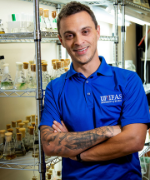Dr. H. Dail Laughinghouse IV: Extension:
Applied Phycology
My extension program complements my research program. With data acquired through my research program, I am able to educate the public on what algae exist in Florida, their identification, and best management practices for control. Further, data acquired through my extension program feed into my research program, that I can in turn, use for extension. I provide leadership and expertise for statewide algal issues, verified by consultations around Florida.
I work closely with county agents and regional specialized agents on water quality, algae and their management. We coordinate on my projects, maintain constant contact, and are an essential component in both my extension program areas. The ultimate goal of my program is to identify the algae present in Florida (especially South Florida) to educate the public and suggest best management practices (BMPs) for their growth, control and management.
Currently, my extension program includes:
-
1: Volunteer Algae Monitoring Program (VAMP) in the Indian River Lagoon estuary (Florida)
The increase of nutrients into aquatic bodies, coupled with the advent of climate change, has increased harmful algal blooms (HABs) worldwide. This is especially prevalent in Florida since the state is a ‘blend’ of rural and urban areas affected by environmental disturbances from urban runoff, sewage and agriculture. Further, Florida has a huge deposit of phosphate, which increases the likelihood of HABs. In summer 2016, Florida Treasure Coast communities in Martin, St Lucie and Indian River counties were impacted by news stories of algae blooms in the waters of the Indian River Lagoon estuary. This news was exacerbated by residents demanding cessation of fresh water releases into this estuary from Lake Okeechobee. Public health authorities in Martin County issued recommendations for people to protect themselves, their families and pets from exposure to cyanobacterial HABs in the Indian River Lagoon estuary. This news resulted in dramatic impacts on businesses, residents and visitors in these communities as the news spread worldwide on CNN and other media outlets. These episodes demonstrate the importance of having informed citizens with an understanding of the problems and threats. Studies have shown the value of using citizen scientists to aid in HAB monitoring programs.
Together with extension faculty, we devised the Volunteer Algae Monitoring Program (VAMP) as a test pilot program to address the need to obtain long-term algae and water quality data and to engage local citizens in these efforts. UF/IFAS Florida Master Naturalist volunteers were selected to adopt a sampling point in the estuary and received training and supplies to conduct water quality testing and algae collection on a monthly basis. These algae samples are surveyed in my lab and reports are submitted to the UF/IFAS St Lucie County Extension where local decision-makers assess the algae-related issues impacting the Indian River Lagoon estuary. -
2: Algae identification and management
There exits poor understanding on the biology, identification and ecology of algae and stakeholders usually ‘black box’ them believing that they are just a group of aquatic ‘plants’. This is incorrect. One forgets that they are microscopic and a group with 3.8 billion years of history, which means that different groups can react differently to aquatic conditions and control and management methods. Further, herbicides and algaecides may not react alike in different water bodies. There are then several things to consider when applying chemicals: 1) algal composition, 2) water conditions, and 3) amount of algae present.
However, not all algae are bad, with an example of Chara that is being used for remediation purposes, especially in the Storm Water Treatment Areas (STAs) managed by the South Florida Water Management District. This alga is good, and understanding its biology and ecology are imperative to recognize how to grow it in different environments. One of the most important aspects of Chara is that it is utilized for phosphorus removal, a nutrient that can limit toxic algal blooms.
The data obtained from this work is used to recommend best management practices (BMPs) to stakeholders, including applicators through trainings and CEU events. This information is also used in my research program for research publications, in addition to EDIS publications.

Assistant Professor
3205 College Ave Davie FL 33314
Davie West
Phone: 954-577-6382
hlaughinghouse@ufl.edu
